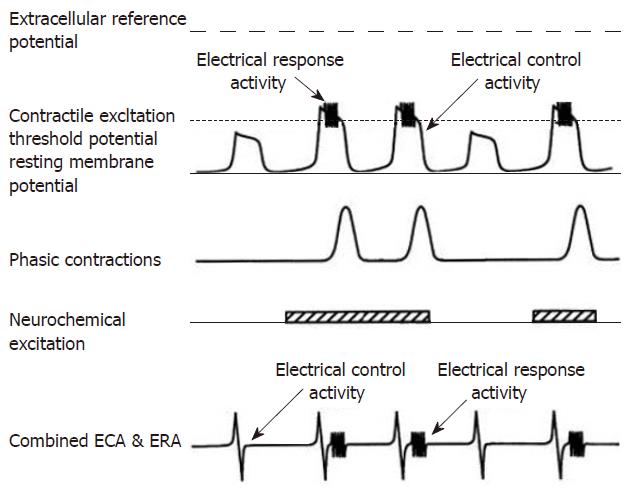Copyright
©2007 Baishideng Publishing Group Co.
World J Gastroenterol. May 21, 2007; 13(19): 2684-2692
Published online May 21, 2007. doi: 10.3748/wjg.v13.i19.2684
Published online May 21, 2007. doi: 10.3748/wjg.v13.i19.2684
Figure 1 The top electrical tracing illustrates the relationship of intracellularly recorded myoelectric activity and neurochemical excitation with contractions.
In the absence of neurochemical excitation, the ECA depolarizations do not exceed the contractile excitation threshold potential. Consequently, no ERA burst is recorded and no contraction occurs during the first and fourth depolarization. When neurochemical stimulation occurs, ECA depolarization exceeds the excitation threshold, an ERA burst occurs and the smooth muscle contracts (cycle 2, 3 and 5). The extracellular electrode recordings are shown in the last tracing and record the follow of currents from a large numbers of smooth muscle cells. The relationship between ECA, neurochemical excitation ERA and contractions is the same as with intracellular recordings. (From Sarna, SK: In vivo myoelectric activity: Methods, analysis and interpretation. In Wood JD (ed): Handbook of Physiology: A Critical, Comprehensive Presentation of Physiological Knowledge and Concepts. Bethesda, MD, American Physiological Society, 1989: 817-863).
- Citation: Otterson MF. Effects of radiation upon gastrointestinal motility. World J Gastroenterol 2007; 13(19): 2684-2692
- URL: https://www.wjgnet.com/1007-9327/full/v13/i19/2684.htm
- DOI: https://dx.doi.org/10.3748/wjg.v13.i19.2684









